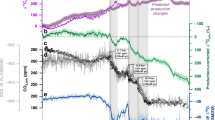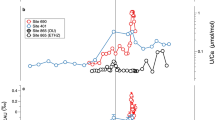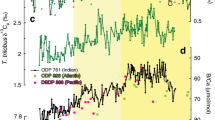Abstract
The rise of atmospheric oxygen fundamentally changed the chemistry of surficial environments and the nature of Earth’s habitability1. Early atmospheric oxygenation occurred over a protracted period of extreme climatic instability marked by multiple global glaciations2,3, with the initial rise of oxygen concentration to above 10−5 of the present atmospheric level constrained to about 2.43 billion years ago4,5. Subsequent fluctuations in atmospheric oxygen levels have, however, been reported to have occurred until about 2.32 billion years ago4, which represents the estimated timing of irreversible oxygenation of the atmosphere6,7. Here we report a high-resolution reconstruction of atmospheric and local oceanic redox conditions across the final two glaciations of the early Palaeoproterozoic era, as documented by marine sediments from the Transvaal Supergroup, South Africa. Using multiple sulfur isotope and iron–sulfur–carbon systematics, we demonstrate continued oscillations in atmospheric oxygen levels after about 2.32 billion years ago that are linked to major perturbations in ocean redox chemistry and climate. Oxygen levels thus fluctuated across the threshold of 10−5 of the present atmospheric level for about 200 million years, with permanent atmospheric oxygenation finally arriving with the Lomagundi carbon isotope excursion at about 2.22 billion years ago, some 100 million years later than currently estimated.
This is a preview of subscription content, access via your institution
Access options
Access Nature and 54 other Nature Portfolio journals
Get Nature+, our best-value online-access subscription
$29.99 / 30 days
cancel any time
Subscribe to this journal
Receive 51 print issues and online access
$199.00 per year
only $3.90 per issue
Buy this article
- Purchase on Springer Link
- Instant access to full article PDF
Prices may be subject to local taxes which are calculated during checkout




Similar content being viewed by others
Data availability
All data generated or analysed during this study are included in this published article and its Supplementary Information.
References
Canfield, D. E. The early history of atmospheric oxygen: homage to Robert M. Garrels. Annu. Rev. Earth Planet. Sci. 33, 1–36 (2005).
Bekker, A. & Kaufman, A. J. Oxidative forcing of global climate change: a biogeochemical record across the oldest Paleoproterozoic ice age in North America. Earth Planet. Sci. Lett. 258, 486–499 (2007).
Rasmussen, B., Bekker, A. & Fletcher, I. R. Correlation of Paleoproterozoic glaciations based on U–Pb zircon ages for tuff beds in the Transvaal and Huronian Supergroups. Earth Planet. Sci. Lett. 382, 173–180 (2013).
Gumsley, A. P. et al. Timing and tempo of the Great Oxidation Event. Proc. Natl Acad. Sci. USA 114, 1811–1816 (2017).
Warke, M. R. et al. The Great Oxidation Event preceded a Paleoproterozoic “snowball Earth”. Proc. Natl Acad. Sci. USA 117, 13314–13320 (2020).
Bekker, A. et al. Dating the rise of atmospheric oxygen. Nature 427, 117–120 (2004).
Luo, G. et al. Rapid oxygenation of Earth’s atmosphere 2.33 billion years ago. Sci. Adv. 2, e1600134 (2016).
Holland, H. D. Volcanic gases, black smokers, and the Great Oxidation Event. Geochim. Cosmochim. Acta 66, 3811–3826 (2002).
Farquhar, J., Bao, H. M. & Thiemens, M. Atmospheric influence of Earth’s earliest sulfur cycle. Science 289, 756–758 (2000).
Farquhar, J. & Wing, B. A. Multiple sulfur isotopes and the evolution of the atmosphere. Earth Planet. Sci. Lett. 213, 1–13 (2003).
Pavlov, A. A. & Kasting, J. F. Mass-independent fractionation of sulfur isotopes in Archean sediments: strong evidence for an anoxic Archean atmosphere. Astrobiology 2, 27–41 (2004).
Catling, D., Zahnle, K. & McKay, C. Biogenic methane, hydrogen escape, and the irreversible oxidation of early Earth. Science 293, 839–843 (2001).
Goldblatt, C., Lenton, T. M. & Watson, A. J. Bistability of atmospheric oxygen and the Great Oxidation. Nature 443, 683–686 (2006).
Hoffman, P. F. The Great Oxidation and a Siderian snowball Earth: MIF-S based correlation of Paleoproterozoic glacial epochs. Chem. Geol. 362, 143–156 (2013).
Kasting, J. F. Methane and climate during the Precambrian era. Precambr. Res. 137, 119–129 (2005).
Claire, M. W., Catling, D. C. & Zahnle, K. J. Biogeochemical modelling of the rise in atmospheric oxygen. Geobiology 4, 239–269 (2006).
Zahnle, K., Claire, M. W. & Catling, D. The loss of mass-independent fractionation in sulfur due to a Palaeoproterozoic collapse of atmospheric methane. Geobiology 4, 271–283 (2006).
Daines, S. J. & Lenton, T. M. The effect of widespread early aerobic marine ecosystems on methane cycling and the Great Oxidation. Earth Planet. Sci. Lett. 434, 42–51 (2016).
Guo, Q. et al. Reconstructing Earth’s surface oxidation across the Archean-Proterozoic transition. Geology 37, 399–402 (2009).
Reinhard, C. T., Planavsky, N. J. & Lyons, T. W. Long-term sedimentary recycling of rare sulphur isotope anomalies. Nature 497, 100–103 (2013).
Philippot, P. et al. Globally asynchronous sulphur isotope signals require re-definition of the Great Oxidation Event. Nat. Commun. 9, 2245 (2018).
Killingsworth, B. A. et al. Constraining the rise of oxygen with oxygen isotopes. Nat. Comm. 10, 4924 (2019); author correction 11, 4996 (2020).
Ono, S. et al. New insights into Archean sulfur cycle from mass-independent sulfur isotope records from the Hammersley Basin, Australia. Earth Planet. Sci. Lett. 213, 15–30 (2003).
Kaufman, A. J. et al. Late Archean biospheric oxygenation and atmospheric evolution. Science 317, 1900–1903 (2007).
Cameron, E. M. Evidence from early Proterozoic anhydrite for sulphur isotopic partitioning in Precambrian oceans. Nature 304, 54–56 (1983).
Bekker, A., Karhu, J. A. & Kaufman, A. J. Carbon isotope record for the onset of the Lomagundi carbon isotope excursion in the Great Lakes area, North America. Precambr. Res. 148, 145–180 (2006).
Crockford, P. W. et al. Claypool continued: extending the isotopic record of sedimentary sulfate. Chem. Geol. 513, 200–225 (2019).
Coetzee, L. L., Beukes, N. J., Gutzmer, J. & Kakegawa, T. Links of organic carbon cycling and burial to depositional depth gradients and establishment of a snowball Earth at 2.3 Ga: evidence from the Timeball Hill Formation, Transvaal Supergroup, South Africa. S. Afr. J. Geol. 109, 109–122 (2006).
Planavsky, N. J. et al. The evolution of the marine phosphate reservoir. Nature 467, 1088–1090 (2010).
Kendall, B. et al. Pervasive oxygenation along late Archaean ocean margins. Nat. Geosci. 3, 647–652 (2010).
Olson, S. L., Kump, L. R. & Kasting, J. F. Quantifying the areal extent and dissolved oxygen concentrations of Archean oxygen oases. Chem. Geol. 362, 35–43 (2013).
Koehler, M. C., Buick, R., Kipp, M. A., Stüeken, E. E. & Zaloumis, J. Transient surface ocean oxygenation recorded in the ∼2.66-Ga Jeerinah Formation, Australia. Proc. Natl Acad. Sci. USA 115, 7711–7716 (2018).
Hoffman, P. F., Kaufman, A. J., Halverson, G. P. & Schrag, D. P. A Neoproterozoic Snowball Earth. Science 281, 1342–1346 (1998).
Mills, B. et al. Timing of Neoproterozoic glaciations linked to transport-limited global weathering. Nat. Geosci. 4, 861–864 (2011).
Bekker, A. & Holland, H. D. Oxygen overshoot and recovery during the early Paleoproterozoic. Earth Planet. Sci. Lett. 317–318, 295–304 (2012).
Humbert, F. et al. Palaeomagnetism of the early Palaeoproterozoic, volcanic Hekpoort Formation (Transvaal Supergroup) of the Kaapvaal craton, South Africa. Geophys. J. Int. 209, 842–865 (2017).
Clarkson, M. O., Poulton, S. W., Guilbaud, R. & Wood, R. A. Assessing the utility of Fe/Al and Fe-speciation to record water column redox conditions in carbonate-rich sediments. Chem. Geol. 382, 111–122 (2014).
Poulton, S. W. & Canfield, D. E. Ferruginous conditions: a dominant feature of the ocean through Earth’s history. Elements 7, 107–112 (2011).
Izon, G. et al. Multiple oscillations in Neoarchaean atmospheric chemistry. Earth Planet. Sci. Lett. 431, 264–273 (2015).
Bekker, A. in Encyclopedia of Astrobiology (eds Gargaud, M. et al.) 1399–1404 (Springer, 2014).
Coetzee, L. L. Genetic Stratigraphy of the Paleoproterozoic Pretoria Group in the Western Transvaal. MSc thesis, Rand Afrikaans Univ. (2001).
Visser, J. N. J. The Timeball Hill Formation at Pretoria—a prograding shore-line deposit. Annals Geol. Surv. Pretoria 9, 115–118 (1972).
Eriksson, K. A. The Timeball Hill Formation—a fossil delta. J. Sediment. Res. 43, 1046–1053 (1973).
Eriksson, P. G. & Reczko, B. F. F. Contourites associated with pelagic mudrocks and distal delta-fed turbidites in the Lower Proterozoic Timeball Hill Formation epeiric basin (Transvaal Supergroup), South Africa. Sedim. Geol. 120, 319–335 (1998).
Eriksson, P. G. et al. The Transvaal sequence: an overview. J. Afr. Earth Sci. 16, 25–51 (1993).
Bekker, A., Krapež, B. & Karhu, J. A. Correlation of the stratigraphic cover of the Pilbara and Kaapvaal cratons recording the lead up to Paleoproterozoic Icehouse and the GOE. Earth Sci. Rev. 211, 103389 (2020).
Hannah, J. L., Bekker, A., Stein, H. J., Markey, R. J. & Holland, H. D. Primitive Os and 2316 Ma age for marine shale: implications for Paleoproterozoic glacial events and the rise of atmospheric oxygen. Earth Planet. Sci. Lett. 225, 43–52 (2004).
Bekker, A. et al. Chemostratigraphy of the Paleoproterozoic Duitschland Formation, South Africa: implications for coupled climate change and carbon cycling. Am. J. Sci. 301, 261–285 (2001).
Schröder, S., Beukes, N. J. & Armstrong, R. A. Detrital zircon constraints on the tectono-stratigraphy of the Paleoproterozoic Pretoria Group, South Africa. Precambr. Res. 278, 362–393 (2016).
Moore, J. M., Tsikos, H. & Polteau, S. Deconstructing the Transvaal Supergroup. South Africa: implications for Palaeoproterozoic palaeoclimate models. J. Afr. Earth Sci. 33, 437–444 (2001).
Van Kranendonk, M. & Mazumder, R. Two Paleoproterozoic glacio-eustatic cycles in the Turee Creek Group, Western Australia. Geol. Soc. Am. Bull. 127, 596–607 (2015).
Krapež, B., Müller, S. G., Fletcher, I. R. & Rasmussen, B. A tale of two basins? Stratigraphy and detrital zircon provenance of the Palaeoproterozoic Turee Creek and Horseshoe basins of Western Australia. Precambr. Res. 294, 67–90 (2017).
Cui, H. et al. Searching for the Great Oxidation Event in North America: a reappraisal of the Huronian Supergroup by SIMS sulfur four-isotope analysis. Astrobiology 18, 519–538 (2018).
Poulton, S. W. & Canfield, D. E. Development of a sequential extraction procedure for iron: implications for iron partitioning in continentally derived particulates. Chem. Geol. 214, 209–221 (2005).
Canfield, D. E., Raiswell, R., Westrich, J. T., Reaves, C. M. & Berner, R. A. The use of chromium reduction in the analysis of reduced inorganic sulfur in sediments and shales. Chem. Geol. 54, 149–155 (1986).
Raiswell, R. & Canfield, D. E. Sources of iron for pyrite formation in marine sediments. Am. J. Sci. 298, 219–245 (1998).
Poulton, S. W. The Iron Speciation Paleoredox Proxy (eds Lyons, T. et al.) (Cambridge Univ. Press, 2021).
Raiswell, R. & Canfield, D. E. Rates of reaction between silicate iron and dissolved sulfide in Peru Margin sediments. Geochim. Cosmochim. Acta 60, 2777–2787 (1996).
Poulton, S. W., Fralick, P. W. & Canfield, D. E. Spatial variability in oceanic redox structure 1.8 billion years ago. Nat. Geosci. 3, 486–490 (2010).
Doyle, K. A., Poulton, S. W., Newton, R. J., Podkovyrov, V. N. & Bekker, A. Shallow water anoxia in the Mesoproterozoic ocean: evidence from the Bashkir Meganticlinorium, Southern Urals. Precambr. Res. 317, 196–210 (2018).
Alcott, L. J. et al. Development of iron speciation reference materials for paleoredox analysis. Geostand. Geoanal. Res. 44, 581–591 (2020).
Johnston, D. T. et al. Placing an upper limit on cryptic marine sulphur cycling. Nature 513, 530–533 (2014).
Cheney, E. S. Sequence stratigraphy and plate tectonic significance of the Transvaal succession of Southern Africa and its equivalent in Western Australia. Precambr. Res. 79, 3–24 (1996).
Beukes, N. J. & Gutzmer, J. Origin and paleoenvironmental significance of major iron formations at the Archean-Paleoproterozoic boundary. Soc. Econ. Geol. Rev. 15, 5–47 (2008).
Zerkle, A. L., Claire, M. W., Domagal-Goldman, S. D., Farquhar, J. & Poulton, S. W. A bistable organic-rich atmosphere on the Neoarchaean Earth. Nat. Geosci. 5, 359–363 (2012).
Izon, G. et al. Biological regulation of atmospheric chemistry en route to planetary oxygenation. Proc. Natl Acad. Sci. USA 114, 2571–2579 (2017).
Mishima, K. et al. Multiple sulfur isotope geochemistry of Dharwar Supergroup, Southern India: late Archean record of changing atmospheric chemistry. Earth Planet. Sci. Lett. 464, 69–83 (2017).
Raiswell, R. et al. Turbidite depositional influences on the diagenesis of Beecher’s Trilobite Bed and the Hunsrück Slate; sites of soft tissue pyritization. Am. J. Sci. 308, 105–129 (2008).
Papineau, D., Mojzsis, S. J. & Schmitt, A. K. Multiple sulfur isotopes from Paleoproterozoic Huronian interglacial sediments and the rise of atmospheric oxygen. Earth Planet. Sci. Lett. 255, 188–212 (2007).
Zerkle, A. L. et al. Onset of the aerobic nitrogen cycle during the Great Oxidation Event. Nature 542, 465–467 (2017).
Acknowledgements
S.W.P. acknowledges support from a Leverhulme Research Fellowship and a Royal Society Wolfson Research Merit Award. A.B. acknowledges support from the University of Johannesburg in the form of a Distinguished Visiting Professorship. D.T.J. acknowledges support from a NASA Exobiology award (NNX15AP58G). We thank R. Walshaw for assistance with SEM analyses.
Author information
Authors and Affiliations
Contributions
S.W.P., A.B. and D.E.C. designed the research, S.W.P., A.B. and A.L.Z. collected samples, and S.W.P., V.M.C. and D.T.J. performed analyses. S.W.P. wrote the manuscript, with contributions from all co-authors.
Corresponding author
Ethics declarations
Competing interests
The authors declare no competing interests.
Additional information
Peer review information Nature thanks Bryan Killingsworth, Lee Kump and Sune Nielsen for their contribution to the peer review of this work.
Publisher’s note Springer Nature remains neutral with regard to jurisdictional claims in published maps and institutional affiliations.
Extended data figures and tables
Extended Data Fig. 2 Geochemical data for the lower part of the Pretoria Group.
Dashed lines on FeHR*/FeT plots represent the boundaries for distinguishing oxic and anoxic deposition, and on Fepy/FeHR* plots represent the boundaries for distinguishing ferruginous and euxinic water-column conditions38. Dashed lines on Δ33S plots are at −0.3‰ and +0.3‰.
Extended Data Fig. 3 Scanning electron microscope images of pyrite and Fe oxide morphologies.
A, EBA-2, Rooihoogte Formation, 1,346.2 m. Sample deposited under oxic conditions; Δ33S = +2.16‰. B, EBA-1, Rooihoogte Formation, 1,168 m. Sample deposited under oxic conditions; Δ33S = +1.77‰. C, EBA-1, Timeball Hill Formation, 1,137 m. Sample deposited under ferruginous conditions; Δ33S = +1.44‰. D, EBA-2, Rooihoogte Formation, 1,335.6 m. Sample deposited under ferruginous conditions; Δ33S = +0.25‰. E, EBA-2, Rooihoogte Formation, 1,338.3 m. Sample deposited under euxinic conditions; Δ33S = +0.17‰. F, EBA-1, Timeball Hill Formation, 706 m. Water-column redox state not analysed; Δ33S = +1.61‰.
Extended Data Fig. 4 Sulfur isotope trends for Rooihoogte–Timeball Hill Formation samples.
A, Orthogonal data regression for samples with MIF-S (Δ33S > 0.3‰), showing the calculated Δ36S/Δ33S slope (blue line) and 3σ confidence interval (shaded blue area). Samples from above the Rooihoogte Formation are denoted as open blue circles. B, Orthogonal data regression for MDF-S samples (Δ33S = –0.3‰ to +0.3‰, showing the calculated Δ36S/Δ33S slope (red line) and 3σ confidence interval (shaded red area).
Extended Data Fig. 5 Sulfur isotope data from Fennoscandia5 and Western Australia21,22.
Extended Data Fig. 6 Simplified geological map of the Transvaal Supergroup outcrop area.
Figure adapted from ref. 70, Springer Nature.
Extended Data Fig. 7 Ocean redox data for EBA-1.
The dashed line on the Fe/Al plot represents the upper boundary for distinguishing anoxia37 and on the FePRS/Al plot the Phanerozoic average68. Dashed lines on the FeHR/FeT and FeHR*/FeT plots distinguish oxic and anoxic deposition38. Dashed lines on the FePRS plot represent the average Phanerozic range (1.80 ± 0.85 wt%; 1σ)68.
Extended Data Fig. 8 Ocean redox data for EBA-2.
The dashed line on the Fe/Al plot represents the upper boundary for distinguishing anoxia37 and on the FePRS/Al plot the Phanerozoic average68. Dashed lines on the FeHR/FeT and FeHR*/FeT plots distinguish oxic and anoxic deposition38. Dashed lines on the FePRS plot represent the average Phanerozic range (1.80 ± 0.85 wt%; 1σ)68.
Supplementary information
Supplementary Tables
This file contains Supplementary Tables 1-4.
Rights and permissions
About this article
Cite this article
Poulton, S.W., Bekker, A., Cumming, V.M. et al. A 200-million-year delay in permanent atmospheric oxygenation. Nature 592, 232–236 (2021). https://doi.org/10.1038/s41586-021-03393-7
Received:
Accepted:
Published:
Issue Date:
DOI: https://doi.org/10.1038/s41586-021-03393-7
This article is cited by
-
Crustal carbonate build-up as a driver for Earth’s oxygenation
Nature Geoscience (2024)
-
The interplay between microbial communities and soil properties
Nature Reviews Microbiology (2024)
-
Cryogenian and Ediacaran integrative stratigraphy, biotas, and paleogeographical evolution of the Qinghai-Tibetan Plateau and its surrounding areas
Science China Earth Sciences (2024)
-
Reconciling discrepant minor sulfur isotope records of the Great Oxidation Event
Nature Communications (2023)
-
Sub-arc mantle fugacity shifted by sediment recycling across the Great Oxidation Event
Nature Geoscience (2023)
Comments
By submitting a comment you agree to abide by our Terms and Community Guidelines. If you find something abusive or that does not comply with our terms or guidelines please flag it as inappropriate.



